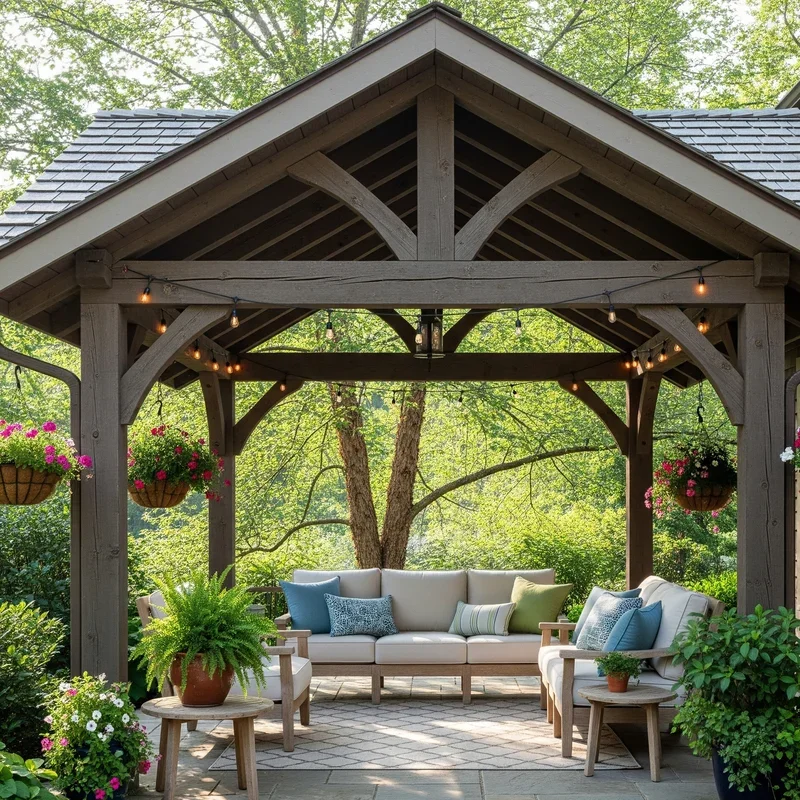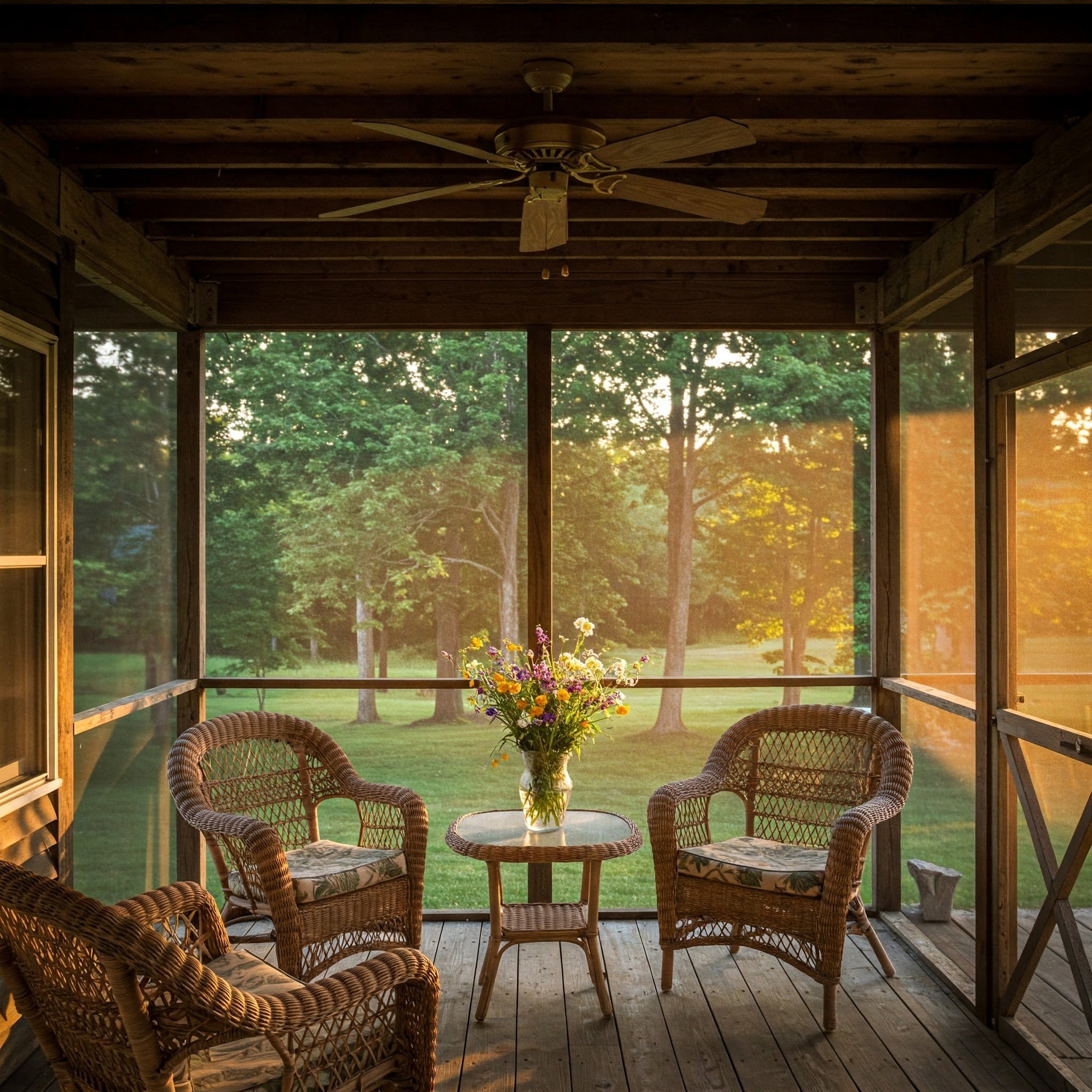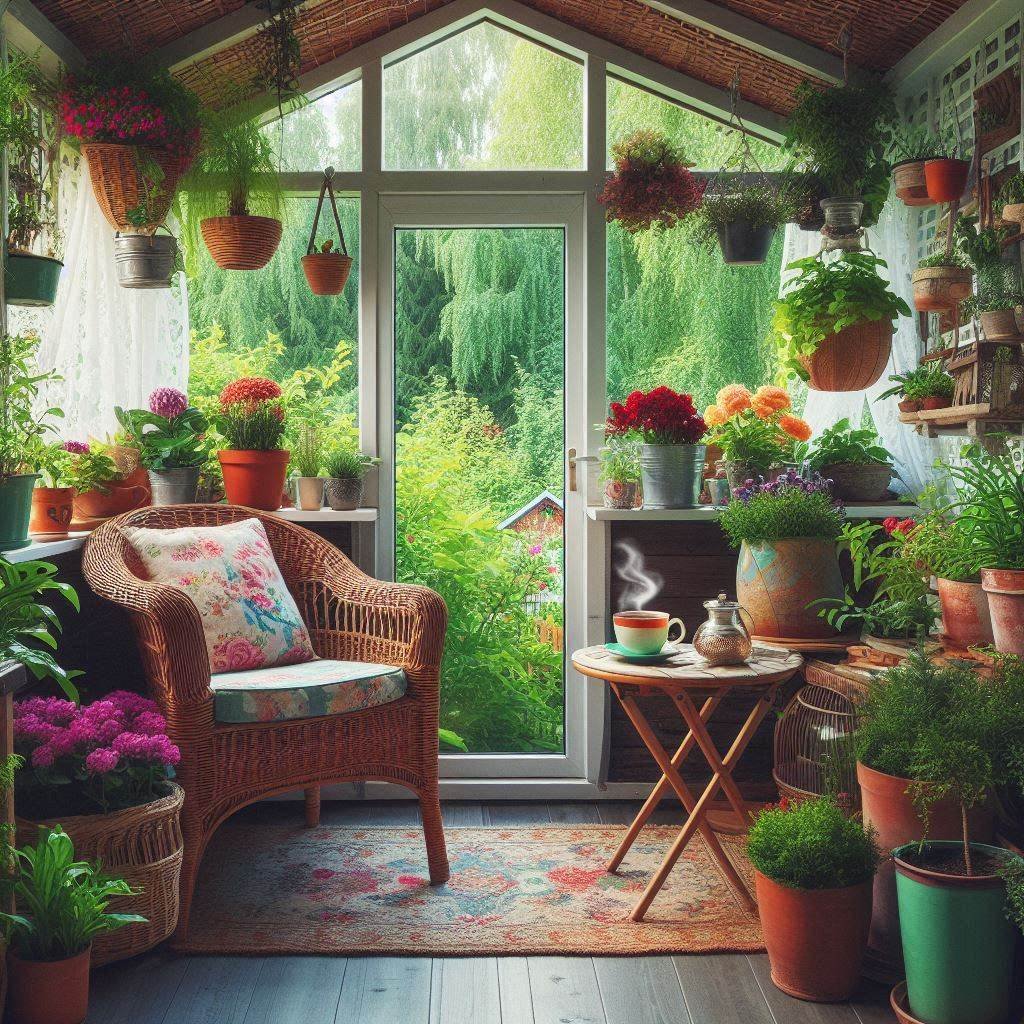15 Covered Porch Ideas to Enhance Outdoor Living
Transform your outdoor space with 15 inspiring covered porch ideas. From cozy retreats to entertainment hubs, find your perfect style!
Remember those summer evenings at grandma's house, swaying on her porch swing while fireflies danced in the yard? That magical feeling doesn't have to stay in the past. Your covered porch holds incredible potential to become the heart of your home, where morning coffee tastes better and evening conversations flow easier. But here's the thing: creating that perfect outdoor living space goes way beyond slapping up a roof and calling it done. Whether you're dreaming of a Southern-style wraparound masterpiece or a sleek modern outdoor room, the right design transforms a simple covered area into your favorite spot in the entire house. Ready to blur those lines between indoor comfort and outdoor freedom? Let's explore ideas that'll make your neighbors wonder why they're still stuck inside!
1. Classic Wraparound Porches: Southern Charm Meets Modern Living
Is there anything more inviting than a wraparound porch that hugs your home like a warm embrace? These architectural beauties do more than boost curb appeal; they create multiple outdoor rooms with distinct personalities. Picture this: morning yoga on the east side, afternoon reading nooks on the north, and sunset cocktails facing west. The continuous roofline provides seamless flow while protecting your home's exterior from weather damage. Traditional designs feature white columns and railings, but modern interpretations play with cable rails, stone pillars, and mixed materials. Width matters here; aim for at least 8 feet to accommodate furniture comfortably. The investment typically returns 84% of its cost in home value, making it both practical and profitable. Add ceiling fans for air circulation, and you've essentially doubled your living space for three seasons of the year.
2. Screened-In Sanctuaries: Bug-Free Bliss
What if you could enjoy every evening breeze without becoming a mosquito buffet? Screened porches deliver that dream, creating outdoor rooms that feel like nature without nature's less pleasant residents. These spaces work overtime as dining rooms, home offices, or sleeping porches on sultry summer nights. The screening options have evolved beyond basic mesh; try solar screens that block UV rays, pet-resistant screens that survive claws, or retractable systems that disappear when bugs do. Flooring choices set the mood: traditional wood for warmth, tile for easy cleaning, or composite decking for zero maintenance. Don't forget the ceiling; beadboard adds cottage charm while tongue-and-groove cedar brings outdoorsy sophistication. Most screened porches cost between $15,000 and $30,000, but considering you'll use it from spring through fall, that's pennies per hour of enjoyment.
3. Modern Minimalist Overhangs: Clean Lines, Maximum Impact
Sometimes less really is more, especially when your covered porch embraces minimalist design principles. These sleek structures feature flat or barely sloped roofs, hidden support systems, and materials like steel, concrete, and glass that scream contemporary cool. The magic lies in the negative space; what you don't add matters as much as what you do. Think floating roofs that seem to defy gravity, supported by impossibly thin columns or cantilevered from the house. Monochromatic color schemes keep things sophisticated, while strategic lighting transforms these spaces into glowing architectural sculptures at night. Furniture follows suit with low-profile pieces in neutral tones and geometric shapes. The minimalist approach actually maximizes your view, creating frames for your landscape rather than blocking it. Budget $20,000 to $40,000 for professional installation, though the clean aesthetic means lower maintenance costs long-term.
4. Rustic Timber Frame Porches: Mountain Lodge Vibes
Want to feel like you're vacationing at a ski lodge every time you step outside? Timber frame porches bring that cozy cabin energy home through massive wooden beams, mortise-and-tenon joinery, and natural materials that age beautifully. These structures make statements with exposed rafters, hefty posts, and brackets that showcase woodworking craftsmanship. The wood choices matter: douglas fir offers affordability, cedar provides natural rot resistance, while reclaimed barn beams add instant character. Stone or brick pillars at the base ground the design and add durability. Inside, consider a wood-burning fireplace or stove to extend usability into winter. Rustic doesn't mean rough; add comfortable seating with plaid cushions, wool throws, and leather accents. The substantial construction means these porches last generations with proper maintenance. Expect to invest $25,000 to $50,000, but you're building an heirloom addition.
5. Mediterranean-Style Loggias: European Elegance at Home
Transport yourself to the Italian Riviera without the jet lag by creating a Mediterranean-inspired loggia. These covered outdoor galleries blur indoor-outdoor boundaries with arched openings, stucco columns, and terracotta tile roofs that whisper "dolce vita." The key elements include graceful arches (not too pointed, not too round), warm earth-tone colors, and natural stone or tile flooring that stays cool underfoot. Wrought iron details on railings, light fixtures, and furniture complete the Old World charm. These spaces beg for dining tables where meals stretch for hours, complemented by built-in pizza ovens or outdoor kitchens. Climbing jasmine or bougainvillea softens hard edges while providing intoxicating fragrances. The covered design protects delicate furnishings, allowing for more elaborate decor like chandeliers and upholstered seating. Mediterranean porches particularly suit stucco or stone homes, creating cohesive architectural stories.
6. Farmhouse Front Porches: Country Comfort Refined
Modern farmhouse style isn't going anywhere, and these porches prove why everyone's obsessed. They balance rustic charm with contemporary comfort through elements like board-and-batten skirting, X-pattern railings, and those Instagram-famous hanging bed swings. White or light gray painted wood dominates, punctuated by black metal accents and natural wood ceilings. The wide-plank flooring, whether real wood or convincing composite, grounds the space in authenticity. Farmhouse porches excel at creating welcoming vignettes: vintage metal chairs around a galvanized tub coffee table, mason jar lighting, and potted herbs in enamelware containers. Don't forget the ceiling fans; traditional styles with schoolhouse lights nail the aesthetic while providing practical cooling. These porches typically span the home's entire front, offering multiple seating areas for different moods. The style works surprisingly well in suburban settings, bringing pastoral peace to any neighborhood.
7. Tropical Lanai Designs: Island Paradise in Your Backyard
Why wait for vacation when you can create your own tropical escape? Lanai-style covered porches embrace island living through natural materials, lush plantings, and breezy designs that maximize airflow. Think bamboo or rattan furniture, thatched roof elements (or modern equivalents), and colors pulled from ocean and jungle palettes. Ceiling fans are non-negotiable, preferably palm-blade styles that enhance the theme. The flooring should handle moisture; sealed concrete with tropical stencils, natural stone, or quality outdoor tile all work beautifully. Privacy screens made from bamboo or lattice covered in flowering vines create intimate spaces. Add a water feature for those soothing sounds that transport you mentally to paradise. Outdoor curtains in flowing white or tropical prints provide adjustable privacy and sun protection. String lights shaped like pineapples or flamingos keep things playful after dark. This style particularly suits ranch homes and properties with pool areas.
8. Victorian Gingerbread Porches: Ornate Beauty Revival
Some houses deserve the full Victorian treatment, complete with elaborate trim work that would make Queen Victoria herself jealous. These porches celebrate craftsmanship through decorative brackets, spindle work, and fretwork that turns structural elements into art. The key is balancing ornate details without overwhelming the space; think of it as architectural jewelry. Paint schemes traditionally feature multiple complementary colors highlighting different elements, though modern interpretations sometimes stick to monochromatic palettes for sophistication. Turned posts, decorative corbels, and fancy railings create visual rhythm. Period-appropriate furniture like wicker peacock chairs and cast iron plant stands complete the look. Modern additions like hidden LED strips can highlight architectural details at night without compromising authenticity. These porches require maintenance commitment; all that detailed woodwork needs regular painting and repair. But for Victorian-era homes, they're essential for historical accuracy and maximum charm.
9. Contemporary Glass-Roofed Spaces: Sky Views Year-Round
Imagine lying on your porch sofa, watching clouds drift by day and stars twinkle at night, all while staying protected from the elements. Glass or polycarbonate roofed porches deliver this dream through transparent or translucent coverings that maintain that outdoor connection. Modern materials include tempered glass, twin-wall polycarbonate, or adjustable louver systems that open to the sky. These roofs require proper engineering for snow loads and drainage, but the results are spectacular. Automated shade systems prevent overheating during summer while maintaining the open feel. The transparency demands attention to what's visible from below; exposed framing should be attractive, whether sleek aluminum or warm wood. Furnishings need UV resistance since they'll receive more sun exposure than traditional covered porches. Rain becomes entertainment rather than inconvenience, creating nature's own sound and light show overhead.
10. Multi-Level Covered Decks: Vertical Entertainment Zones
When your lot slopes or you want maximum outdoor living space, think vertically with multi-level covered decks. Each tier serves different functions: grilling up top, dining in the middle, lounging below. The vertical separation creates natural privacy while maintaining connection through strategically placed stairs. Upper levels often feature pergolas or retractable awnings rather than solid roofs, preserving light for lower spaces. Cable railings maintain sightlines between levels while meeting safety codes. Built-in planters at level transitions soften edges and add greenery at eye level. Lighting becomes crucial for safety and ambiance; consider LED strips under handrails and recessed lights in stair risers. The multi-level approach actually costs less per square foot than single-level additions of the same total size. Design connections between levels thoughtfully; spiral stairs save space while wide traditional stairs encourage flow between zones.
11. Outdoor Kitchen Porches: Culinary Adventures Al Fresco
Move over, indoor kitchen; the real cooking action happens outside now. Covered porches with integrated kitchens transform meal prep from chore to entertainment, keeping cooks connected to guests while working. Essential elements include proper ventilation for grills, weatherproof cabinetry, and surfaces that handle temperature extremes. Granite countertops resist heat and weather, while stainless steel appliances survive outdoor conditions. Don't stop at just a grill; pizza ovens, smokers, and even outdoor dishwashers expand possibilities. The roof structure needs special consideration for ventilation hoods and possibly natural gas lines. Create zones: prep areas near the house for easy indoor access, cooking stations with exhaust ventilation, and serving bars where guests gather. Under-counter refrigerators, ice makers, and warming drawers mean fewer trips inside. Include a dining area to enjoy meals immediately, when flavors peak.
12. Four-Season Sunrooms: Weather-Proof Wonderlands
What if your covered porch could laugh in the face of winter? Four-season sunrooms deliver year-round outdoor living through insulated glass walls, climate control, and weatherproof construction that handles everything nature throws. These sophisticated spaces cost more initially but deliver value through constant use. Energy-efficient windows with Low-E coatings manage heat transfer, while insulated roofing systems prevent condensation problems. Heating and cooling options range from extending existing HVAC to independent mini-split systems. Flooring must handle temperature swings; porcelain tile, luxury vinyl, or sealed concrete work better than hardwood. The controlled environment means you can use indoor furniture and decor, expanding design possibilities infinitely. These rooms excel as home offices, exercise spaces, or greenhouse gardens. Building codes typically treat them as conditioned space, potentially adding square footage to your home's value. Investment ranges from $30,000 to $80,000, depending on size and finishes.
13. Japanese-Inspired Covered Gardens: Zen Meets Architecture
Find your inner peace through Japanese-inspired covered porches that emphasize harmony, simplicity, and connection to nature. These designs feature clean lines, natural materials, and thoughtful proportions that create meditative spaces. Traditional elements include exposed wooden beams, shoji-style screens for adjustable privacy, and floors of bamboo or stone. The roof might incorporate traditional tiles or modern interpretations using metal or composite materials. Water features are essential; even small fountains provide the sound element crucial to Japanese garden design. Plantings focus on texture and form: ornamental grasses, carefully pruned trees, and moss gardens. Furniture stays low and minimal: floor cushions, low tables, and perhaps a single statement chair. Lighting should be subtle and indirect, creating shadows that add depth. These porches particularly suit modern homes or those seeking tranquil retreats from chaotic daily life.
14. Coastal Cottage Porches: Beachy Keen Retreats
Bring beach vacation vibes home with coastal cottage porches that celebrate seaside living, whether you're oceanfront or landlocked. The color palette pulls from sand, sea, and sky: whites, soft blues, seafoam greens, and driftwood grays. Materials must withstand moisture and salt air (real or imagined): composite decking, vinyl railings, and marine-grade finishes. Ceiling treatments like white beadboard or painted wood planks reflect light and create that cottage feel. Furniture combines comfort with weather resistance: all-weather wicker, teak, or poly lumber in classic Adirondack styles. Nautical touches like rope railings, ship lights, and oar decor enhance the theme without going overboard. Outdoor curtains in striped or solid coastal colors provide sun protection and privacy. These porches excel at casual entertaining; think clambakes, sunset cocktails, and sandy feet always welcome. The relaxed aesthetic means less pressure for perfection and more emphasis on enjoyment.
15. Smart Tech Integrated Porches: Future-Forward Outdoor Living
Welcome to the porch of tomorrow, where technology enhances rather than intrudes on outdoor relaxation. Smart porches incorporate automated features that adjust to your preferences: motorized screens that respond to weather sensors, programmable heating systems that pre-warm spaces, and lighting that adjusts to activities. Voice-controlled speakers hidden in ceiling structures provide soundtrack without visible equipment. Smart fans adjust speed based on temperature, while misting systems activate during heat waves. Security cameras and smart locks integrated discretely maintain safety without compromising aesthetics. USB outlets and wireless charging stations built into furniture keep devices powered. Automated shade systems respond to sun position, maintaining comfort throughout the day. Entertainment options include weatherproof TVs that rise from furniture or drop from ceilings. The technology investment adds $5,000 to $15,000 to porch costs but creates spaces that practically run themselves.
Conclusion
Your covered porch represents unlimited potential for extending your living space and enhancing your lifestyle. Whether you choose rustic charm or high-tech sophistication, the perfect design awaits discovery. Start with your home's architecture, consider your climate, and think about how you'll actually use the space. The investment in covered outdoor living pays dividends in daily enjoyment and lasting home value!
Read next: 15 Front Porch Railing Ideas to Boost Curb Appeal
Frequently Asked Questions
Q1: What's the average cost of adding a covered porch?
Basic covered porches start around $15,000; elaborate designs can exceed $50,000 easily.
Q2: Do I need permits for a covered porch addition?
Most municipalities require permits for covered structures attached to homes.
Q3: Which porch flooring lasts longest outdoors?
Composite decking and porcelain tile offer superior durability with minimal maintenance required.
Q4: How deep should a covered porch be?
Minimum 6 feet depth; 8-10 feet allows comfortable furniture placement and movement.
Q5: Can I add a covered porch to any house style?
Yes, proper design ensures covered porches complement any architectural style beautifully.





























